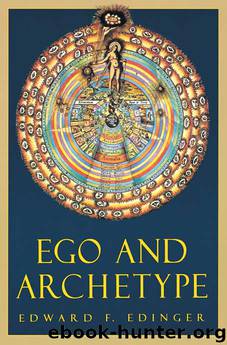Ego and Archetype by Edward F. Edinger

Author:Edward F. Edinger
Language: eng
Format: epub
Publisher: Shambhala
4.MAN AS THE IMAGE OF GOD
A particularly clear expression of the idea of Christ as paradigm of the ego is found in the apocryphal “Acts of John.” In chapter ninety-five Jesus says to his disciples: “A mirror am I to thee that perceivest me.”22 Again in chapter ninety-six, he says: “Behold thyself in me . . . perceive what I do, for thine is this passion of the manhood, which I am about to suffer.”23
If the figure of Christ is a mirror for the ego, it is certainly reflecting a paradoxical double image. Is the individual ego then both man and God, ego and Self? Jung touches on this same question in his alchemical studies. He writes: “. . . with their sun symbol they (the alchemists) were establishing an intimate connection between God and the ego.”24 After noting that the alchemists were dealing with unconscious projections which are natural phenomena beyond interference by the conscious mind, he then reaches the conclusion that: “. . . nature herself is expressing an identity of God and ego.”25 And later he adds: “This is understandable when we realize that a world-creating quality attaches to human consciousness as such.”26
Perhaps the same problem lies at the root of the homoousia-homoiousia conflict of the fourth century. Is Christ to be considered of the same substance as the Father or only of similar substance to the Father? If we equate Christ with the ego and the Father with the Self, the psychological issue is immediately clear. The decision was made in favor of the “same substance” doctrine and this has been the functioning image in the dogma ever since. Hence the implication is that the Western psyche is rooted in a myth which equates man with God, the ego with the Self.
The same issue is expressed in the idea that Christ is an image of God. In Colossians 1:15 Christ is described as “the image of the invisible God . . .” (R.S.V.) Again in Hebrews 1:3 He is called “the express image of his (God’s) person.” (A.V.) This manner of speaking reminds us of Gen. 1:26 where God says: “Let us make man in our own image.” If Christ is an image of God and man likewise has been made in God’s image, Christ would be equated with man. Origen resolves the problem by making Christ the second in a three-fold series of God-Christ-Man:
We, therefore, having been made according to the image, have the Son, the original, as the truth of the noble qualities that are within us. And what we are to the Son, such is the Son to the Father, who is the truth.27
If we formulate this idea psychologically, it means that the real ego relates to the Self only via an ideal ego as paradigmatic model (Christ) which bridges the two worlds of consciousness and the archetypal psyche by combining both personal and archetypal factors.
With these rather ambiguous reflections we encounter analytical psychology’s most difficult problem, namely, the nature of the relation between the ego and the Self.
Download
This site does not store any files on its server. We only index and link to content provided by other sites. Please contact the content providers to delete copyright contents if any and email us, we'll remove relevant links or contents immediately.
Rewire Your Anxious Brain by Catherine M. Pittman(17590)
Talking to Strangers by Malcolm Gladwell(11880)
The Art of Thinking Clearly by Rolf Dobelli(8844)
Mindhunter: Inside the FBI's Elite Serial Crime Unit by John E. Douglas & Mark Olshaker(7835)
Becoming Supernatural by Dr. Joe Dispenza(7107)
Change Your Questions, Change Your Life by Marilee Adams(6642)
The Road Less Traveled by M. Scott Peck(6636)
Nudge - Improving Decisions about Health, Wealth, and Happiness by Thaler Sunstein(6634)
The Lost Art of Listening by Michael P. Nichols(6474)
Enlightenment Now: The Case for Reason, Science, Humanism, and Progress by Steven Pinker(6407)
Win Bigly by Scott Adams(6313)
Mastermind: How to Think Like Sherlock Holmes by Maria Konnikova(6236)
The Way of Zen by Alan W. Watts(5800)
Daring Greatly by Brene Brown(5643)
Grit by Angela Duckworth(4738)
Big Magic: Creative Living Beyond Fear by Elizabeth Gilbert(4723)
Men In Love by Nancy Friday(4327)
Flow by Mihaly Csikszentmihalyi(4053)
The Four Tendencies by Gretchen Rubin(4024)
